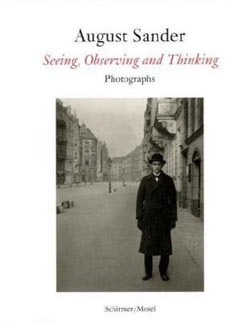Review: August Sander - Seeing, Observing, Thinking

August Sander is one of the usual suspects. A discussion of portraiture will inevitably have the author mention Sander and his work. If you have ever seen any of his portraits, it will be obvious why: Many of them are in a league of their own, catching glimpses of people living in a world that was either disintegrating or at least massively changing - as Germany changed from a monarchy to a military dictatorship (a pro forma monarchy) to an increasingly unstable democracy to a fascist dictatorship, against the background of various economic crises, plus the Great Depression, plus at some stage hyperinflation, and against the background of scientific revolutions, which resulted in massive improvements of living conditions as well as industrialized mass slaughter. And as if this wasn’t crazy enough, when Sander was ready to have his massive body of portraits shown, the Nazis prevented him from doing it, because his portraits did not adhere to their idea of what Aryans were supposed to look like (never mind that apart from the foreign minister the whole Nazi elite did not even remotely look like such Aryans). (more)
After the Nazis’ ban on his portrait work, Sander started working on landscapes, and he documented his home town of Cologne. Having lost one of his sons in a Nazi prison, Sander also witnessed the destruction of Cologne via Allied bombing raids, and the burning of thousands of his negatives. Can anyone imagine what all of this must have meant for the artist and human being August Sander?
I don’t think you can go through life filled with such tragedy and adversity without the feeling that there are very deep and fundamental connections between yourself and other people, and between yourself and Nature - and I am convinced this might be the best way to explain how Sander managed to take all those portraits.
With books containing his portraiture being easy to come by, August Sander - Seeing, Observing, Thinking presents a wider view of the artist, with portraits (some very well know, others less so), landscapes, and photographs of flowers. It is, if you will, the complete August Sander. In addition, you get some introductory text and the transcript of a radio lecture by the artist from 1931, entitled “Photography as a Universal Language.”
Against the background of the history of the work it’s slightly unfair, but nevertheless, Sander’s landscapes strike me as weak and run-of-the-mill. But it is important to see them, and August Sander - Seeing, Observing, Thinking provides a good opportunity to do that.
Given that his portraits still have such power over us, now might be the time to look out for that first re-evaluation of that work, the book that will move beyond the current standard narratives around one of the finest photographers of the 20th Century.
August Sander: Seeing, Observing, Thinking; photography by August Sander, with contributions by Agnes Sire, Gabriele Conrath-Scholl, Thomas Schatz-Nett, and August Sander; 160 pages, Schirmer Mosel, 2009